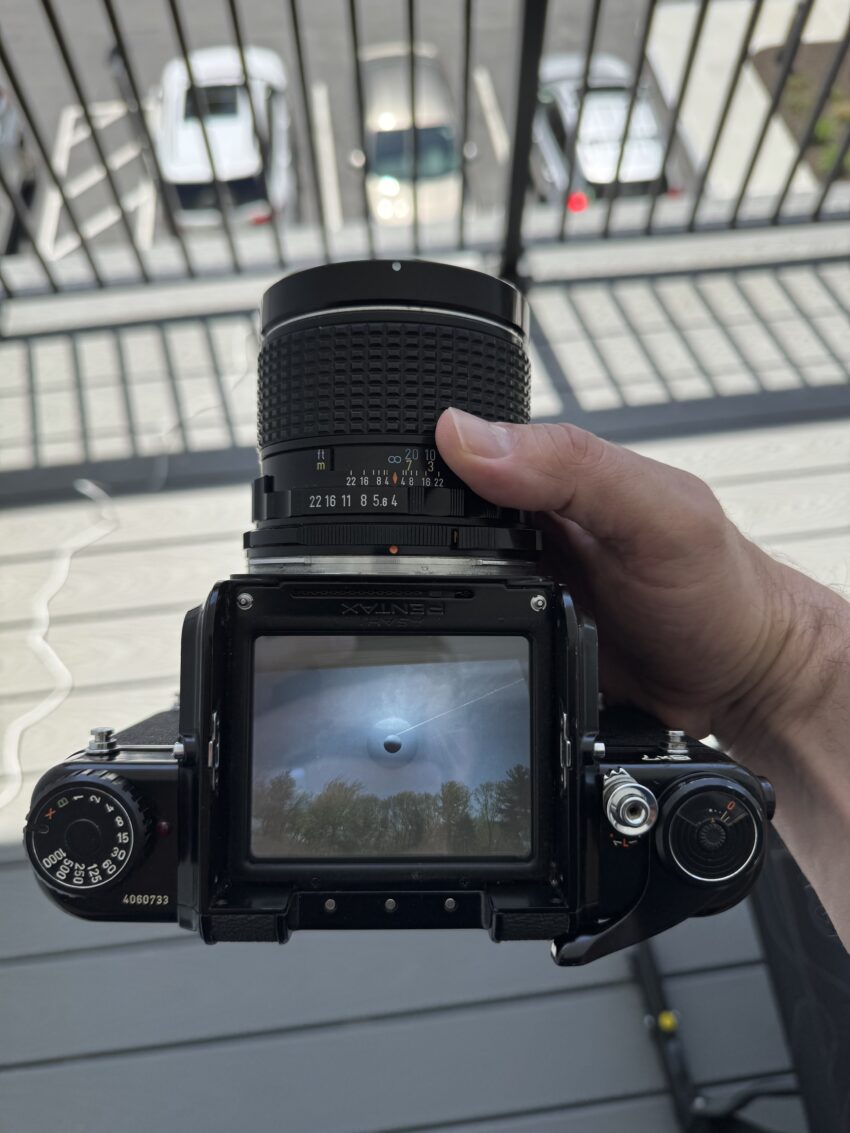I’ve taken a few test shots with the Pentax 6×7. The feel is completely different than my Hasselblad 500cm. Not worse or better, just different. It took me a bit of time to get the film loaded properly. Once loaded I didn’t have the counter all the way to number 1, and thought the camera was broken. It wasn’t and I just had to wind the film more. The negatives are currently drying, but appear very nice. I’ll have them scanned shortly.
The History of the Pentax 6×7 Medium Format Camera
The Pentax 6×7 holds a legendary status among medium format photographers. Introduced in the 1960s and produced in various iterations for over three decades, it combined the handling of a 35mm SLR with the image quality of medium format film. Its robust design, extensive lens lineup, and distinctive 6x7cm negative size made it a favorite of studio, portrait, and landscape photographers — and it remains one of the most popular medium format systems in the analog revival.
Origins: Medium Format for the 35mm Shooter
As 120 film cameras grew in popularity among professionals, most systems — from Hasselblads to Mamiyas — retained a boxy, waist-level finder design. Pentax, already renowned for its successful 35mm SLRs like the Spotmatic, saw an opportunity: create a medium format SLR that felt familiar to 35mm users in ergonomics and operation.
In 1969, Asahi Optical Co. introduced the Pentax 6×7 — a camera that looked and operated like a giant 35mm SLR but shot huge 6x7cm negatives. Often jokingly called a “giant Spotmatic,” it offered through-the-lens (TTL) metering, interchangeable lenses, prisms, and a mirror mechanism that shook the ground when fired.
Key Features of the Pentax 6×7
- 6x7cm negatives (actual size ~56x70mm): Nearly 5x the surface area of 35mm film.
- Pentaprism or waist-level finder options
- Focal plane shutter with speeds from 1s to 1/1000s + Bulb
- Mirror lock-up feature (on later models) to reduce vibration
- Interchangeable lenses via a breech-lock bayonet mount
- A wide range of SMC Takumar and SMC Pentax 67 lenses, including legendary glass like the 105mm f/2.4
Its large negatives produced stunning detail and tonality, especially when paired with fine-grain films like Ektar 100 or Portra 160. Photographers dubbed 6×7 the “ideal format” — large enough to rival 4×5 in quality, but still portable.
Evolution: Pentax 6×7 → 67 → 67II
1. Pentax 6×7 (1969–1989):
The original model ran for 20 years with minor revisions. Early versions lacked mirror lock-up (a point of criticism), but later revisions addressed this. TTL metering was optional via the prism viewfinder. It earned a reputation for reliability and ruggedness, though the massive mirror slap could cause camera shake if handheld at low shutter speeds.
2. Pentax 67 (1989–1998):
A cosmetic and mechanical update. The “Pentax 67” dropped the “6×7” name but kept the same format. It featured improved electronics, quieter film advance, and standard mirror lock-up. Internally, the camera remained largely the same, using the same lenses and accessories.
3. Pentax 67II (1998–2009):
The final and most refined version. It introduced AE (auto-exposure) with the new AE prism finder, a more ergonomic grip, improved metering, and better electronics. It was now powered by a single 2CR5 lithium battery, and offered more stable mirror movement. The 67II felt more modern but maintained full compatibility with legacy lenses and finders.
Notable Lenses
- 105mm f/2.4: Arguably the most famous — known for its sharpness and creamy bokeh.
- 55mm f/4 and 75mm f/4.5: Wide-angle staples for landscape work. The 55mm f4 is what I currently own and is pictured in the photo above.
- 135mm Macro, 165mm LS, and 200mm f/4: Specialized optics used in studio or telephoto work.
- 45mm f/4 and 300mm f/4: Offered for those needing extreme focal lengths.
The glass was known for its classic rendering, solid build, and the ability to resolve detail across the large 6×7 frame.
The Cult Following and Digital Afterlife
Despite being discontinued in 2009, the Pentax 6×7/67/67II remains highly sought-after. Its blend of traditional SLR mechanics, a massive negative, and top-tier lenses gives it unique character. The camera has found new life among:
- Film revivalists seeking large negatives with a cinematic look
- Portrait photographers craving the rendering of the 105mm
- Landscape shooters appreciating the resolution and detail
It also pairs well with modern film stocks like Kodak Ektar, Portra, and even black-and-white classics like Ilford HP5.
Additionally, some users adapt 67 lenses to digital medium format systems like the Fujifilm GFX series, extending the life and value of the optical system.
Limitations and Quirks
While beloved, the Pentax 6×7 isn’t without flaws:
- Heavy: Weighs over 5 lbs (2.3kg) with lens and prism.
- Mirror slap: Significant vibration if mirror lock-up isn’t used.
- No interchangeable backs: Unlike modular systems like Hasselblad or Mamiya RB67.
- Battery-dependent: Especially the 67II, which won’t fire without power.
Yet, these quirks are often seen as part of the charm — a tradeoff for the unique experience and stunning image quality the system delivers.
The Pentax 6×7 was born out of a vision to bridge the gap between 35mm familiarity and medium format quality. For over 40 years, it served countless photographers in portrait studios, out in nature, and in fashion shoots around the world. Today, it stands as a testament to analog design — a beautifully oversized SLR that continues to inspire awe every time its shutter slams home.
Whether you’re a collector, a serious shooter, or a newcomer exploring the world of film, the Pentax 6×7 remains a true heavyweight — in every sense of the word.

